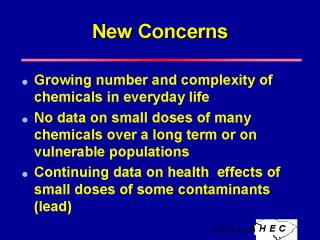| front |1 |2 |3 |4 |5 |6 |7 |8 |9 |10 |11 |12 |13 |14 |15 |16 |17 |18 |19 |20 |21 |22 |23 |24 |25 |26 |review |
 |
Little is known about the health effects of the growing numbers of natural and synthetic chemicals in the environment. Questions of dose, chemical interactions, brief versus long exposure times, and other factors complicate understanding and predicting health effects. Since case control studies of populations is unethical, the only available means of determining effects on human health are: - Laboratory animal experiments. - Data from worker studies. - Studying persons exposed through unintended releases and disasters. The effects of lead poisoning are better understood than most other chemicals, but not all chemicals have been analyzed for health effects. Few have been analyzed for long-term exposure at small doses. The impact of small dose exposures over long periods of time are not understood as yet. Resource: The Pew Environmental Health Commission at the Johns Hopkins School of Public Health. See report, “Healthy from the Start: Why America Needs a Better System to Track and Understand Birth Defects and the Environment.” |